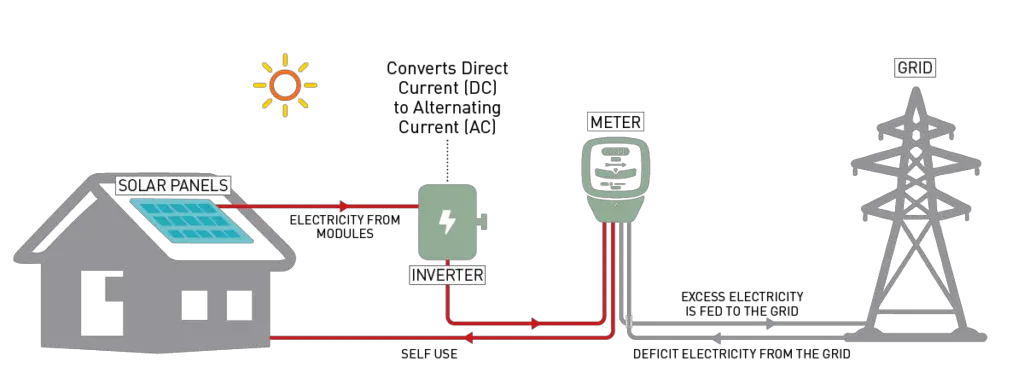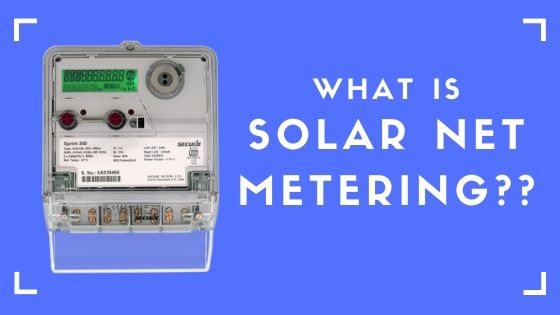Solar net metering is used all over the world as a billing mechanism for solar on grid system. It is a great initiative to make solar energy more affordable and should be there in place for long time.
Solar net metering is a billing mechanism put in place that allows solar roof top owner to export any excess electricity that their solar is producing during the day and import that electricity from the grid during night or times when solar is not producing electricity.
For example if your solar produces 20 units of electricity during the day time and only 10 units is your live consumption, then the remaining 10 units of electricity will be exported to the grid which you can import during the night when your solar is not generating power.
Solar on grid system with net metering is a battery free system which makes going solar affordable for home owners and reduces the maintenance cost of solar to almost zero.
What is Solar Net Metering?

When a person installs a grid tied solar system the electricity bill he gets at the end of every month is as per net metering.
Net metering is a billing mechanism which allows the the solar rooftop owners to export the excess electricity that his/her solar generates during the day time to the utility grid and import electricity from the grid when his solar is not generating electricity like at night.
Before we go solar all of us have a unidirectional meter that keeps track of how much units of electricity we are pulling from the utility grid.
For example, in a month if we pull 100 units of electricity from the utility grid, the meter will show reading of 100 kWh and we will get electricity bill for those 100 kWh of electricity.
But after going solar this unidirectional meter is replaced by a bi-directional meter known as net meter. As the name suggests a net meter keeps track of how many units are being imported from the utility grid and how many units are being exported to the grid.
So the electricity bill you will get at the end of the month is the difference between import and export.
For example, let’s say you have installed a 5 kW solar on grid system with net metering. It produces 575 units of electricity every month. This month out of those 575 units of electricity which your solar has produced you have utilized 200 units of electricity directly from the solar (live consumption when sun was shining) and the rest 375 units are exported to the utility grid through net meter.
When the sun is not shining (during night) you import 150 units of electricity from the grid in the entire month.
Hence for this month your net electricity consumption would be import – export = 150 kWh – 375 kWh = – 225 units.
Since your solar has exported 225 kWh more than what it has imported you will not get any electricity bill for this month and the excess 225 units which you have exported to the utility company will be credited in you next month electricity bill.

How Solar Net Metering Works in Different Scenario:
- Sun is shining: When the sun is shining you will pull the needed electricity from the solar panels and any excess electricity if left will be exported to the utility grid. These exported units of electricity can be imported from the grid at night when solar is not producing any electricity. If at the end of the month your export is more than import then the net units of electricity will be credit to your next month electricity bill.
- At night: At night since the sun is not shining your solar panels won’t generate any electricity, whatever electricity you need will be completely imported from your utility grid.
- During monsoon: When it’s raining outside your solar will generate 50 % – 60% units of electricity of its average generation, hence any excess electricity that is needed during the rain will be pulled from the grid.
- During excess requirement: Let’s say there is some function at your house, hence your electricity requirement has doubled. During that time you will pull electricity from the solar panels but if your solar can’t provide the needed power then the remaining power will be pulled from the utility grid. Best part of on grid solar system with net metering is that you will never lose power no matter how much high is your load.
- No grid: If your electricity provider has shut down electricity grid (no power) for some maintenance, then your net metered solar system will also stop working because when the grid is down (during power cut) some technician is doing maintenance of the grid and if your solar pumps electricity into the grid the technician will get electrocuted. Hence for this safety reason all the solar on grid inverters comes with a safety feature known as anti-islanding property. This helps to shuts down the solar system, the moment your electricity provider cuts power.
If you don’t like to read articles then watch this video on solar on grid system with net metering.
Myths about Solar Net Metering:
- Electricity Is Stored By Utility Company: This is not true as the excess electricity exported by you will most probably be used by your neighbor. Since electricity has passed through the net meter the exact number of units you have exported has been captured which can be used during billing.
- You Can Generate Income: If you have some extra area on top of your roof where you plan to install solar panels and sell the excess electricity to the electricity provider, then please stop because this is not allowed. As per net metering policy in most countries at the end of every financial year your electricity provider will buy all your excess units of electricity and only pay for 10 % of your annual requirement and the rest will be taken by them without any rebate. The money will be credited in your electricity bill and will be used for future billing. Don’t expect a cheque from your electricity provider.
Eligibility Criteria for Solar Net Metering:
Based on your type of electricity connection (HT/LT), size of your solar project and DISCOM the eligibility criteria might vary this is just a broad overview you can find more information on your electricity provider or DISCOM website.
- Sanctioned Load: In most states in India, it is mandatory that your sanction load should be equal to or more than your solar system capacity. For example if you are installing a 15 kW solar system then your sanction load should be more than or equal to 15 kW, if not then you have to first apply for sanction load enhancement and then for solar net metering. You can check your electricity provider website to know the exact eligibility.
- Transformer capacity: In most of the states in India, you can install solar system on only 60 % of your area transformer capacity. For example if your area transformer is of 700 kVa then at max a total of 420 kVa of solar can be installed on it not more than that.
Advantages of Solar Net Metering System:
Solar on grid system with net metering makes it easier to go solar and drastically reduces your electricity bill. some of the benefits of solar net metering are:
- No Battery Required: There is no need to buy any expensive battery since a net metered system doesn’t need one, as all the excess electricity is exported to the utility grid. You can imagine your electricity provider as a large battery bank storing all your electricity and giving it back whenever you need it.
- Negligible Maintenance: Since this is a battery free system the only maintenance that is required is to clean the solar panels to prevent it from dust accumulation.
- Reduce your electricity bill: Using solar on grid system with net metering you can reduce your electricity bill by 90 % for the next 20 – 25 years. You will still get fixed meter cost as your electricity bill even after installing solar.
- Save Environment: Going solar not only saves electricity bill but environment as well. One kilowatt of solar reduces 1 ton of Co2 emission annually. This is a big achievement in today’s time keeping in mind the increasing pollution level we are witnessing.
Disadvantages of Solar Net Metering System:
The only disadvantage I see in a solar on grid system with net metering is that since it’s a grid tied system you need to have proper grid connectivity in your area to install it. If your like in a place where there is no grid or you see frequent power cuts during the day then solar net metering system is of no use to you.
Other big disadvantage is that since it is a battery free system, it has zero backup. If your electricity provider cuts power then your solar will also stop working.
Hence solar net metering is only introduced in major cities where there are no power outages.

Conclusion:
Solar net metering gives major boost to the renewable market and shouldn’t be stopped. It is an affordable solar system which helps customers to zero down their electricity bill and forget about high maintenance cost of solar.
If you have a solar net metering system installed at your house or office then please share your experience in the comments section, it might help others.
If there is something about solar net metering that you would like me to add in this blog then please write it in the comments section and share this article on WhatsApp, facebook, reddit if it has added any value to you.
Thank You 🙂
Reference:
- https://www.seia.org/initiatives/net-metering
- https://science.howstuffworks.com/environmental/green-science/net-metering.htm
- https://www.adanielectricity.com/RooftopSolar
- https://www.tatapower-ddl.com/solar-rooftop/net-metering-connection
- https://www.bestundertaking.com/apply_net_metering.asp
- https://www.mahadiscom.in/consumer/solar-rooftop-net-metering/
- https://connect.torrentpower.com/tplcp/index.php/callcenter/index?pagename=Solar





